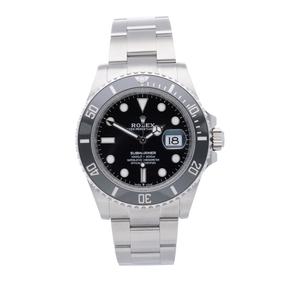Rolex GMT-Master II price development
When the word "Rolex" is mentioned in conversation, watch lovers immediately prick up their ears. After all, the Rolex manufactory, headquartered in Geneva, has been a core player in the watch market for decades, and many insiders agree: every good collection should include Rolex watches. In this article, we focus on the world-famous Rolex GMT-Master II and examine the timepiece's price development in the past and future.
Rolex GMT-Master II - the "original"
The Rolex GMT-Master II is sometimes referred to as the "original" GMT model. Despite a rapidly growing market and a huge number of competing products, there is hardly a GMT timepiece that can compete with Rolex watches of this type. This is primarily due to the history of these special luxury watches: The Rolex GMT-Master II was the first GMT watch to feature a split and colored bezel.
Often compared to the Rolex Submariner diver's watch and quite similar to the Rolex Explorer II in many respects, the GMT-Master II undoubtedly stands on its own and embodies the ultimate dream watch for many a watch enthusiast. The watch, featuring sapphire crystal and a richly detailed dial, is now available in a variety of different versions. For example, there are models with cases made of steel, white gold , or Everose gold combined with an Oyster or Jubilee bracelet and a functional Oysterlock clasp—the choice is endless!
At this point, we'd like to briefly discuss Rolex's most popular GMT-Master references. First and foremost, these are the "Pepsi" watches with a red and blue bezel (relaunched in 2018 under the reference 126710BLNR), closely followed by the "Coke" model with a red and black bezel. Also highly sought-after is the newer Rolex GMT-Master II "Batman" (Ref. 116710LN) with an Oyster bracelet and a blue and black bezel.
Important information about the movement
Whether it's made of stainless steel or solid gold, at the heart of the Rolex GMT-Master II always ticks a caliber 3285 with a 48-hour power reserve. This high-quality movement, designed specifically for travelers, allows you to keep track of three time zones simultaneously. The local time can be easily adjusted using the crown without having to stop the watch. This extremely practical complication has long since won over more than just frequent travelers.
Rolex GMT-Master II price history
Of course, the development of GMT-Master II prices is of particular interest to collectors and investors. After all, price trends provide insight into the financial opportunities offered by resale and the future direction the market might take.
Current price
It goes without saying that it's almost impossible to give a general market price for the Rolex GMT-Master II models. Prices vary considerably from model to model, not only in terms of the list price, but also, and most importantly, in the market price. While the list price for the Rolex "Batgirl" and "Pepsi" models in stainless steel is just under €11,000, the Oyster Perpetual GMT-Master in 18-karat Everose gold is offered at a list price of around €40,000. These are significant price differences that by no means translate directly into market prices. Despite inflation, a significant increase in value can be observed in the market, which is why Rolex GMT-Master II watches sometimes change hands for many times the list price.
Currently, the Rolex "Batgirl" model with its delicate Jubilee-style bracelet is often available for around €25,000. The legendary " Pepsi " watch in its two-tone design is closer to €30,000. In comparison, the market price of "Batman" watches tends to be somewhat lower, fluctuating between €20,000 and €23,000. In terms of market price, all GMT-Master II models have experienced price increases across the board. The recent high inflation rate has only put a minor damper on this price trend, so that Rolex GMT-Master II watches continue to trade at comparatively high market prices.
Historical increase in value
Time to take a closer look at the price development of Rolex watches in the past. On average, the value of the Rolex GMT-Master II luxury watch increased by a whopping 231% between 1994 and 2016. As already mentioned, inflation slowed price growth somewhat, but compared to similar competitor products, Rolex timepieces remained relatively stable on the market during this period.
Price development in the coming years
Of course, it's always difficult to realistically estimate future prices. This is simply because too many unpredictable factors influence the market price. Nevertheless, we would like to venture a cautious outlook into the future. Considering the price development of the Rolex GMT-Master II models over the past years and decades, there is clearly potential for appreciation. While the prospects are certainly not equally good for all Rolex references, especially among iconic models – such as "Pepsi" or "Coke" – there are likely to be some luxury watches whose value is far from reaching its peak. This assumption is also supported by the regular price increases that Rolex makes to its list price every few years. In most cases, a higher list price has a fairly direct impact on market prices and drives upward price development.
Example - Rolex Pepsi price development
To delve a little deeper into the topic of price development, let's take a look at how the price of the Rolex "Pepsi" has changed over the years. The list price, which was once €9,000, was most recently increased to €10,700 in early 2023. The Rolex watch with sapphire crystal and an Oyster Perpetual case steadily gained value on the market, but initially remained below the €20,000 mark. Prices then rose sharply, requiring an investment of at least €30,000 to own a Rolex " Pepsi ." Now prices have settled down a bit, so with a bit of luck, you can snag a model for €23,000 to €25,000. But how long this will last is questionable. It is quite to be expected that popular references - of which "Pepsi" clearly belongs - may experience a further price increase.
Resale value
The resale value of Rolex's GMT-Master II timepieces is stable, with a clear upward trend. Many references – whether in steel or white gold – have proven to be absolutely worthwhile investments. However, investing in a watch is rarely a 100% "safe bet." No one can predict exactly how values will develop or at what price a watch will be offered for sale in the coming years. Investing in a luxury timepiece is therefore always a matter of the heart, one that involves a certain amount of risk that cannot be calculated down to the last detail.
Conclusion - List prices do not reflect market prices
The Rolex GMT-Master II watches are a good example of how the list price does not necessarily reflect the market price. While Rolex has increased the list price for GMT-Master II models from time to time, the watches have experienced incomparably greater increases in value on the market. This phenomenon—which has also been observed with the Submariner Date—makes the Rolex GMT-Master II watches a particularly attractive option for collectors and investors hoping for a lucrative resale in the coming years.















